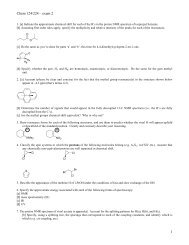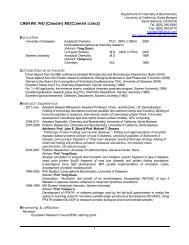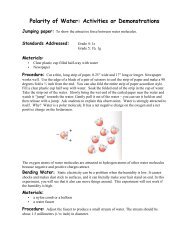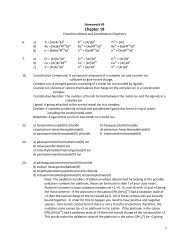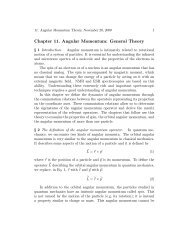Chapter 7. The Eigenvalue Problem
Chapter 7. The Eigenvalue Problem
Chapter 7. The Eigenvalue Problem
Create successful ePaper yourself
Turn your PDF publications into a flip-book with our unique Google optimized e-Paper software.
<strong>7.</strong> <strong>The</strong> <strong>Eigenvalue</strong> <strong>Problem</strong>, December 17, 2009 2<br />
aspects of the eigenvalue problem for matrices and do not discuss numerical<br />
methods for solving it. When we need a numerical solution, we use<br />
Mathematica. For demanding calculations, we must use Fortran, C, orC++,<br />
since Mathematica is less efficient. <strong>The</strong>se computer languages have libraries<br />
of programs designed to give you the eigenvalues and the eigenvectors when<br />
you give them the matrix.<br />
§ 2 Some general considerations. It turns out that the eigenvalue problem<br />
A|ψ = λ|ψ has many solutions and not all of them are physically meaningful.<br />
We are interested in this eigenvalue problem because, if it arises<br />
from an observable, the eigenvalues are the spectrum of the observable and<br />
some of the eigenfunctions are the pure states of the observable. In addition,<br />
the operator representing the observable is Hermitian, because its spectrum,<br />
which consists of all the values the observable can take, just contain only real<br />
numbers.<br />
Before we try to solve the eigenvalue problem, we need to decide how<br />
we recognize which eigenstates correspond to pure states: these are the only<br />
eigenstates of interest to us.<br />
In <strong>Chapter</strong> 2, we examined the definition of the probability and concluded<br />
that kets |a i and |a j representing pure states must satisfy the orthonormalization<br />
condition<br />
a i | a j = δ ij (4)<br />
§ 3 Normalization. Let us assume that we are interested in solving the<br />
eigenvalue equation<br />
Â|ψ = λ|ψ (5)<br />
It is easy to see that if α is a complex number and |ψ satisfies Eq. 5 then<br />
|η = α|ψ satisfies the same equation. For every given eigenvalue we have<br />
as many eigenstates as complex numbers. <strong>The</strong> one that is a pure state must<br />
be normalized. We can therefore determine the value of α by requiring that<br />
|η satisfies<br />
η | η =1 (6)<br />
Using Eq. 5 in Eq. 6 (and the properties of the scalar product) leads to<br />
α ∗ αψ | ψ =1 (7)<br />
or<br />
α ∗ α = 1<br />
ψ | ψ<br />
(8)




